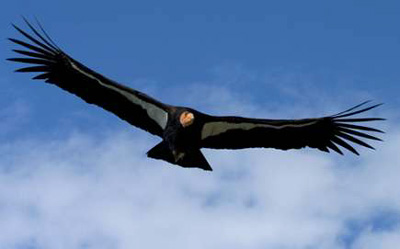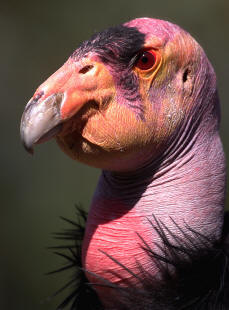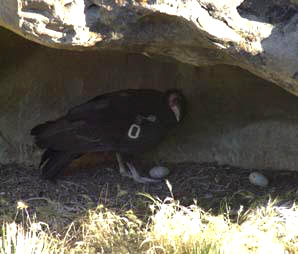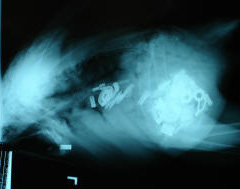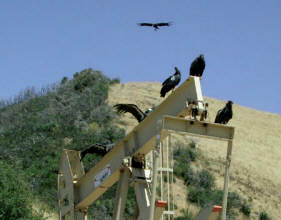Gymnogyps californianus
- Endangered – Endangered Species Act (1967)
- Endangered – California Endangered Species Act (1971)
- Fully Protected – California Department of Fish and Wildlife
- Critically Endangered – IUCN Red List (2017)
The California condor is the largest bird in North America, with a wingspan of up to nine and half feet. It is also one of our country’s most imperiled animals. Fewer than two dozen condors remained in the wild in the 1980s when a controversial decision was made to capture all remaining wild condors and breed them in captivity. Now, two decades later, more than 200 condors command the skies in the wild, including more than 128 flying free in California. Most condor habitat in California is in the Los Padres National Forest, highlighting the importance of protecting this critical habitat.
With their numbers on the rise, condors still face a variety of threats, including habitat loss, oil and gas drilling activities, lead poisoning, shooting, microtrash ingestion, and collisions with power lines. ForestWatch and a dedicated team of volunteers are working to reduce many of these threats in and around the Los Padres National Forest.
The Decline of the Condor
Thousands of years ago, the bird ranged throughout the western and southern parts of North America, from British Columbia to Baja California, including parts of Arizona, New Mexico, Texas, and even Florida, though now the condor is found only in a small u-shaped area in Southern California, as well as in parts of Arizona and Baja California. Throughout this time period the bird was revered by native peoples, who celebrated the condor in cave paintings and religious rituals. The condor retains its cultural significance to the Chumash and other native peoples today.
By 1900 the condor’s range became almost exclusively restricted to California, as the bird increasingly became a victim of shooting, habitat depletion, lead poisoning from bullet fragments in animal carcasses, and egg shell thinning from the pesticide DDT. The California condor is now one of the most endangered birds in the world, with more than 150 condors in the wild, and about the same number in captivity. The population of condors reached perilously low numbers in the 1980s, with only nine birds in the wild when the decision was made to capture all the remaining birds for a captive breeding program.
Early Protection Efforts
Recognizing these threats, in 1937 the U.S. Forest Service established the first sanctuary for the condor, encompassing about 1,200 acres near the headwaters of the Sisquoc River in the Los Padres National Forest. In 1947 a second sanctuary – the Sespe Condor Sanctuary – was established in the Los Padres, covering an additional 35,000 acres. The Sespe Condor Sanctuary was then expanded to 53,000 acres in 1951.
In 1953 the California Department of Fish and Game made it unlawful to “take” any condors. In 1967 the bird was included on the nation’s first federal list of endangered species; and in 1971 the condor was officially protected under the California Endangered Species Act. In the next few years, the U.S. Fish and Wildlife Service would acquire Hopper Mountain and Bitter Creek National Wildlife Refuges to preserve important foraging and roosting grounds for the condor. In 1976 the Fish and Wildlife Service also designated critical habitat for the condor in nine areas in California, including areas around the Sisquoc and Sespe Condor Sanctuaries and other areas of the southern portion of Los Padres National Forest, Hi Mountain and Castle Crags in the Los Padres in San Luis Obispo County, and lands in Kern County.
The Captive Breeding Program
Despite these protections, condor populations continued to decline, and 1982 marked the lowest population numbers for the condor, with less than two dozen birds in the wild and three held in captivity. By 1986 the wild population was so low that the controversial decision was made to catch the remaining nine condors and breed them exclusively in captivity to maximize genetic diversity and survival of the chicks. The last wild condor was captured in the Los Padres National Forest’s Sespe Condor Sanctuary in April 1987.
After five years of captive breeding, wildlife biologists began to release condors back into the wild in 1992 at the Sespe Condor Sanctuary. The release program got off to a rough start, however, with several condor deaths, and the birds were recaptured. The condor program was reevaluated, and changes such as power line and human aversion programs were implemented to minimize the threats to the released condors.

Releases were continued in 1995 starting with the Sespe Condor Sanctuary, and today the Los Padres remains as the primary condor reintroduction site in California. Biologists also started releasing condors in Arizona in 1996 and other sites such as the Ventana Wilderness, Pinnacles National Monument, Bitter Creek, and Baja California in the following years. As greater numbers of birds are reintroduced, condors have also been seen in the Angeles National Forest, Sequoia National Forest, and San Bernadino National Forest, moving into their historic range. They can travel as far as 150 miles per day to scavenge for food (the carcasses of dead animals which they locate with their very keen eyesight in open areas such as grasslands and beaches.)
The Condor Recovery Program has the long-term goal of establishing two stable populations of condors, one in California and one in Arizona, each with 150 condors and 15 breeding pairs. As of December 2014, there are 128 condors in the wild in California, including 103 in Los Padres National Forest and 25 in Pinnacles National Park, 73 in Arizona and Utah, and 27 in Baja California. The population-building process is slow-going for the condors though, as it takes them about six to eight years to reach sexual maturity and a condor pair may only lay one egg every two years. Several condor chicks have successfully hatched in the wild since releases began, however, and the number is continuing to increase.
Current Threats to the Condor
With the ability to fly more than 150 miles in a single day, and a penchant for curiosity, the California condor is particularly susceptible to human development. It depends on large swaths of land for foraging, is exposed to high levels of environmental toxins due to its scavenging behavior, and has life history characteristics that do not allow for rapid recovery from depleted populations. Condors mate for life, have long life spans (up to 60 years by some estimates), and take up to six years to reach maturity. Moreover, a mated pair may only lay a single egg, every two years. Thus losses incurred at any stage in a condor’s life, adult or juvenile, can have a heavy impact on the condor population.
Lead Bullets
In the 1800s and 1900s the greatest threats to the condor were lead poisoning from bullet fragments in animal carcasses, shooting of the condors by hunters, and habitat depletion. By the 20th century these threats had been exacerbated by increased human population, and added to with the poisoning of animals considered pests (such as coyotes) and the increased use of agricultural pesticides such as DDT, which caused the thinning of eggshells and subsequent crushing of eggs. This threat diminished with the banning of DDT in the US, but no action was taken until very recently to decrease the amount of lead in bullets, which the condors would consume when feeding on carcasses or gutpiles left by hunters. The State of California passed a law in 2007 requiring hunters to use lead-free ammunition throughout the condor’s range. In 2013, the state legislature extended this law across the entire state of California, and it formally took effect in 2015.
Microtrash Ingestion
Condors continue to be threatened by collisions with powerlines and consumption of microtrash (small pieces of broken glass, bullet casings, bottle caps, and other small pieces of metal). Microtrash in particular is quickly becoming one of the greatest threats to the condor’s continued existence, representing the number one cause of condor chick mortality. Adult condors, for yet unknown reasons, pick up these small pieces of trash and take them back to their nests, where the condor chicks eat it. If they consume too much trash the chicks can’t survive without having the trash surgically removed. With the help of volunteers and nonprofit organizations like ForestWatch, efforts are being made to clean up microtrash from areas that condors are known to visit.
Oil Development
In the Los Padres National Forest, the California condor also faces the potentially disastrous threat of oil-drilling. The Los Padres is the only national forest in California that allows oil drilling, and the main drilling area – the Sespe Oil Field – is located along the boundary of the Sespe Condor Sanctuary and the Hopper Mountain National Wildlife Refuge.
Condors can become habituated to oil drilling equipment and there are several documented cases of condors being harmed by oil drilling activities. In April 2002, the U.S. Fish & Wildlife Service had to flush Condor #100 from an oil pad, and later recorded oil on its face and wings. The agency later determined that the condor became oiled while trying to tear an oily rag from a pipe. Federal biologists also noted in 2005 that a condor became oiled due to “a small spill of oil that occurred when the condor was present and flew down to the spill before the workers could remove the oil.”
Other condors have been found with oil on their heads, according to the Fish & Wildlife Service. Additionally, several oil spills have occurred in or near condor habitat in recent years, including a major oil spill in the Sespe Oil Field that covered three miles of Tar Creek in January 2007. Reportedly no condors were harmed in this oil spill, though the oil came all too close to areas along the creek where condors have been observed drinking and bathing.
Urban Sprawl
Additionally, urban sprawl in southern California continues to threaten condor habitat. While the release areas for the condors are located on public lands, condors range long distances to forage for food, and much of their historical foraging habitat is either developed, or under threat of development. Key among these are Tejon Ranch in Kern County, where more than 12,000 homes are proposed.
ForestWatch: Helping to Protect the Condor
ForestWatch is dedicated to protecting the California condor and the magnificent habitat of this giant bird, and is the only local organization working to protect the condor from runaway oil development. In 2005, the federal government approved a plan to expand oil development in areas dangerously close to condor habitat. We filed a lawsuit to challenge the plan, and that case is still pending in federal court. In 2007, ForestWatch successfully halted a proposal to drill two new oil wells in foraging habitat for the condor, along the edge of the Sespe Condor Sanctuary.
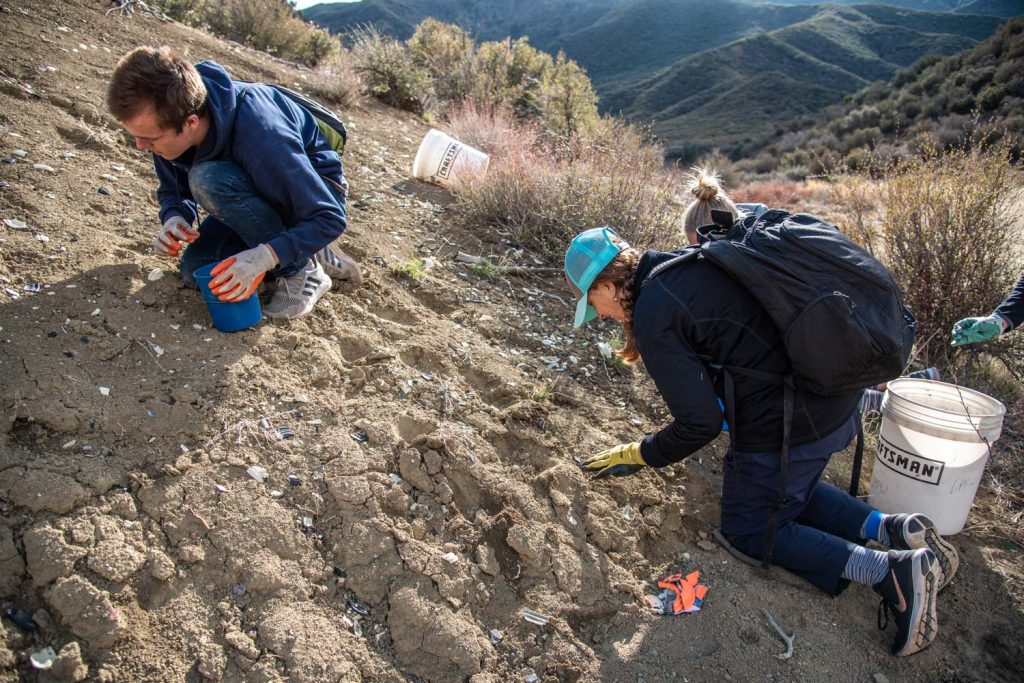
In 2007, ForestWatch began organizing teams of volunteers to clean up microtrash from sites where condors are known to visit. After initial efforts on Whittaker Peak near the Sespe Wilderness, we expanded our efforts in late 2007 to include more remote backcountry sites throughout the Los Padres National Forest and have continued these projects for more than 14 years. If you would like to help (and see some spectacular scenery at the same time), sign up to join us on our next microtrash cleanup!
Condor Resources
To learn more about the California condor, the Condor Recovery Program, and threats to the condor, we encourage you visit the websites of the following government agencies and nonprofits involved with protecting this amazing bird and the habitat that it has called home for thousands of years:
- Defenders of Wildlife
- Center for Biological Diversity
- Audubon Society
- Hi-Mountain Lookout
- Save Tejon Ranch
- Ventana Wildlife Society
- Birdlife International
- Hopper Mountain National Wildlife Refuge
More Information
- From Birdlife.org: The Problem of Microtrash.
- Ending resource abuse: Oil Drilling.
- Read the California condor’s species account.
How You Can Help
Want to help us protect the condor? Join us on our next microtrash cleanup. Click here to sign up and receive notice of our next outing.
Books
Get these books at our Trading Post. All proceeds support our efforts to protect the condor.
- Condor: To the Brink and Back – The Life and Times of One Giant Bird, by John Nielsen (2006)
- Return of the Condor: The Race to Save Our Largest Bird from Extinction, by John Moir (2006)

